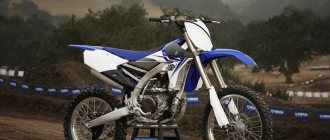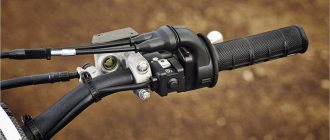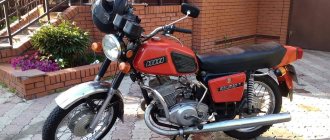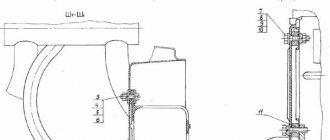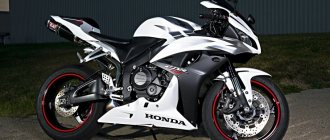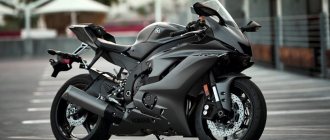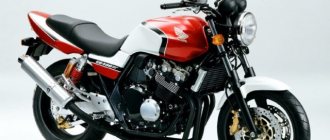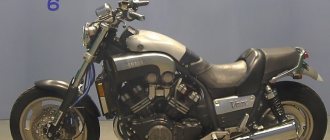Japanese motorcyclesYamaha motorcycles
If this bike were an icon, then before writing about it, you should ask for a blessing. Because the Yamaha YZF R1 is truly a legendary machine. Such tales are born to amaze the imagination, take away peace, break records and change destinies.
Well, as a substitute for a blessing, let’s touch the gas tank with our palm, pick up some dirt from the wheel and rub it over our palm.
He is beautiful! Everything - from the sharp “pike” muzzle to the fervently upturned tail - R1 seems to be declaring: “I’ll break all records like Tuzik a hot water bottle!”
And it’s vomiting! World championships, national championships: France, Spain, Germany, England...
Design
In the case of the Yamaha R1, the photo does not convey all the grace of the motorcycle. A swift silhouette, born after numerous aerodynamic tests, a predatory squinting of the headlights... It seems that the bike is not driving along the road, but is flying over it. Perhaps this is so, if you remember what speed he is capable of developing. Over the past twenty-odd years, it has changed noticeably in appearance, but both old and new Yamaha P1s look very stylish .
Flaws
- Price. Despite the small cubic capacity, the new bike costs no less than the flagship R1.
- Hard sofa. It’s perfect for traveling on tracks, but driving somewhere far away is problematic.
- Low power. Motorcycle for one season. After which you want something more.
- Dynamics. More than 15 seconds for sports is not even interesting.
and dignity
Both ordinary motorcyclists and professional racers note the machine’s high reliability, efficiency and good driving characteristics for its class.
- Ideal for learners/beginners.
- Excellent handling.
- Low fuel consumption.
- Good maneuverability.
- Appearance is no worse than the flagship.
- Brembo brakes.
Specifications
When designing the new flagship, Yamaha engineers went all out, offering customers a bike designed for the race track. Since then it has been constantly improved and modified, and the latest generations do not have much in common with the first, but they are united by the use of advanced technologies at the time of release, so that the technical characteristics of the motorcycle always remain at the highest level.
Engine
All generations are equipped with a liquid-cooled engine (4 cylinders) , first with a carburetor, and then with an injector. Power depends on the specific model, over time it has increased from 150 to 200 hp. , and the power output of the Yamaha YZF R1 exceeded 1 hp. per 1 kg of mass. The engine capacity did not change - 998 cubic centimeters . The maximum torque has changed, but only slightly, from 108 to 112 Nm . Modern examples have a top speed of 300 km/h with acceleration from 0 to 100 km/h in 2.8 seconds .
Transmission
All modifications of the YZF R1 are equipped with a gearbox-6 with a quickshifter , which helps to change gears. By the way, they are quite long, and even on the first one you can accelerate to 90-100 km/h, although you shouldn’t do this regularly - the engine won’t say “thank you”.
Chassis and brakes
The chassis is made of high-strength aluminum alloy, and in 2002 engineers first used the new Deltabox . It turned out to be very successful, and the overall rigidity of the frame increased by 30% . about the braking system , except that they are close to ideal . No wonder the brakes from the R1 were subsequently installed on many other models of the company. From a technical point of view, they are almost perfect, and the ABS system makes them even more reliable.
Electronics
The motorcycle has enough of it - an electronic throttle grip, an electronic YCC-T throttle, Öhlins electronic suspensions (on the R1M version) ... This all complicates independent repairs, and in most cases you have to contact qualified motorcycle services that have the necessary equipment.
Weight and dimensions
The fresher the bike, the more it weighs. The first copies of the Yamaha YZF had a dry weight of 198 kg , and for the latest, newest ones, this parameter increased to 206 kg . You can feel it statically, but once you start moving, the bike immediately begins to seem light as a feather. And thanks to its compact dimensions, it can easily squeeze between cars in city traffic jams.
Controllability
What can you expect from a flagship sportbike designed to win on the track? If you think it should steer perfectly, then you're right. But there is a downside to this - an incorrect or untimely reaction can lead to a fall, since the Yamaha P1 reacts very sensitively to the slightest twist of the throttle or turn. But thanks to the huge reserve of power, it does not pay attention to the presence or absence of a passenger, and no matter how much the pilot weighs - this bike doesn’t care, it is able to rush towards the horizon in a few seconds.
Fuel consumption
The Yamaha P1 does not have a moderate appetite. The consumption declared by the manufacturer reaches 6.9 liters per 100 km , and with aggressive driving it can be even higher. The tank volume is 18 liters (or 17, depending on the generation), and the sportbike prefers the AI-98. You can safely pour AI-95 into old carburetor units.
Motorcycle price
The cost depends on the year of manufacture and condition. A new bike from a dealer will cost about 1.8 million rubles , and an ancient R1 from 1998-2000 can be found on the secondary market for 180-200 thousand . But it’s better to look at options from 2003 and older, since in 2002 the carburetors were replaced with an injector, and a year later the company eliminated all minor defects. And connoisseurs of a more recent design who do not have the budget for a new motorcycle can pay attention to the Yamaha YZF R1 2007 or younger - that’s when a deep restyling was carried out.
Motorsport[edit]
The bike scored five victories at the Macau Grand Prix between 1999 and 2013. Lorenzo Alfonsi won the 2004 FIM Superstock 1000 Cup in 2004, followed by Didier Van Keymeulen in 2005. [36] Yamaha World Superbike riders Troy Corser and Noriyuki Haga finished 2nd and 3rd respectively. in the 2008 World Superbike Championship season. [36] Yamaha World Superbike rider Ben Spies won the 2009 World Superbike Championship, recording 14 wins and 11 pole positions in one season in WSBK. [36] The Yamaha factory racing team with riders N. Nakasuga, P. Espargaro and B. Smith won the 2015 Suzuka 8 Hour Endurance Race. [37] Katsuyuki Nakasuga, Alex Lowes, Pol Espargaro won the 2016 Suzuka 8 Hours endurance race. Tommy Hill won the British Superbike title in 2011 aboard a YZF-R1. Yamaha rider Josh Brookes won the 2015 British Superbike Series title. [38]
Repair and tuning
Due to its complex design, it is not easy to repair the bike yourself, although this does not interfere with maintenance. But if problems arise, it is better to contact a motorcycle service center.
Repair
The Yamaha YZF-R1 is a difficult motorcycle to repair. To get to any part, you may have to scatter half the bike in the corners of the garage, removing the plastic, gas tank, exhaust and something else. And modern generations are equipped with so many electronics that diagnostics require a connection via a bus, and, accordingly, a laptop with special software.
Spare parts
They are not cheap. In the event of a minor breakdown, the owner will not go broke, but the average price of spare parts for a Yamaha P1 will be higher than for a Honda CB 400 or Suzuki GSX-R600.
Tuning
There are many upgrades available, there are tons of them in one official Yamaha catalog. A carbon body kit instead of the usual plastic, new exhausts , gearbox feet, grips, mirrors... If only we had the money, the motorcycle could be turned into a real monster. In a good way!
Motorcycle modifications
The model appeared in 1998, but the first modification was discontinued already in 1999. Already in 2000, the first restyling took place, and in 2002 the third generation, equipped with an injector, went into production. The following restylings took place in 2004, 2006 and 2007, but during this time no significant changes were made. On the secondary market, by the way, there are plenty of 2004 R1s at affordable prices - especially many fourth-generation copies were produced.
There were no noticeable changes in 2008 either, and the 2011 R1 became the last version of the sportbike without built-in traction control. 2015 was marked by the release of a new modification, the Yamaha YZF R1M, and at the same time the production of the eighth generation, the latest at the moment, began. Since then, there have been no changes, with the exception of a few small things, and the Yamaha P1 2022 or 2022 is practically no different from its counterparts released several years earlier.
The birth of a legend. History of the model.
At the time of birth it was the fastest motorcycle on the planet !
Up to a hundred - less than three seconds, and only seven and a half - up to two hundred. However, the bike did not become a “death capsule”, because along with such incredible speed characteristics it received excellent handling, gaining fame as a very “racer-friendly” machine. The designers managed to achieve this: firstly, by moving the bike’s center of gravity as low as possible, and, secondly, by reducing the wheelbase and increasing maneuverability.
The legendary motorcycle is already 16 years old, and during all this time its recognizable appearance has changed, if at all, not too significantly, which means it was successful from the very beginning.
The 2002 Erka differed insignificantly from the first motorcycle: an improved injection system and easy suspension upgrades. The main difference is a new, cast frame with minimal welding, which makes it more rigid.
Two years later, another model appeared, easily recognizable by its front-mounted air intakes. There were no significant changes in the design - the brakes and steering wheel were slightly modernized, equipped with a damper.
And only in 2007, the model range was replenished with a bike with a modified engine with a 4-valve arrangement per combustion chamber. However, the declared 182 “horses” look cool only on the stands. In practice, on the way to the drive wheel, 36 of them run away somewhere...
2009 was marked by the appearance of a number of improvements on the sportbike, designed not to increase speed, make cornering easier, or save a couple of milliseconds on anything else. No! Erka was equipped with several ignition maps for different weather and type of road surface. It seems that for the first time the designers of a crazy sportbike seriously, like adults, were concerned about the safety of the pilot.
The trend continued and in 2012 the Erka arrived with traction control. And here the designers were original: this bike does not have tilt angle sensors. Their function is performed by sensors located on the wheels.
Advantages and disadvantages
To produce the YZF R1, Yamaha used all the technologies available to it, so the disadvantages of the sportbike stem from its advantages.
Advantages
- Crazy acceleration dynamics . Not a single ultra-expensive sports car can compare with the Yamaha P1 in this regard.
- Great brakes . They have become a real standard in the world of motorcycles.
- Stylish and recognizable design . Even those bikers who have never ridden anything other than a Ural know what this model looks like.
- Refined handling . This is especially noticeable on the track.
Flaws
- Engines on first-generation specimens are prone to oil starvation if their horizon changes, so the motorcycle is not very suitable for a stunt.
- At the bottom the bike behaves nervously, reacting sharply to the slightest change in the throttle position.
- It is not easy to maintain and repair modern YZF-R1s yourself, and all operations at dealers are expensive.
Owner reviews
It was the Yamaha P1 that showed me where adrenaline comes from)) After the meeting with the seller, I took the bike and went home, I had never experienced such sensations in my life. At first it was scary to drive around the city; turn the handle sharply 1/5, and there is a risk of flying into a pole or car. The motorcycle is crazy, I'm delighted. Dmitry, Moscow.
I switched from the CBR 600, which was the second of my three sports, I didn’t want to change my beloved Honda, but I fell in love with Erku at first sight. The characteristics are crazy, the comfort is so-so, but it looks so that the number of passers-by turning their heads at it is in the dozens every day, and these are only those whom I myself notice. R1 is the king of sportbikes! Sergey, Krasnodar.
At first I drove a 1998 YUZF R1, the motor I received was damaged, a month later the motor died - the valves were bent. I used it for spare parts, and for the next season I bought the same one, but 2008. It feels like you’re sitting on the same motorcycle, only the instrumentation has become prettier, and the character of the engine has become more friendly, not so harsh, smart electronics prevent you from making a mistake. But the power hasn’t gone away, the acceleration is such that it pulls you back across the seat. Vasily, St. Petersburg.
Photo gallery
From our review you can find out how good this motorcycle is; the photo selection will perfectly complement the image you have formed.
FAQ
- What is the maximum speed of the bike? 300 km/h for the latest generations, and a little less for the first.
- What kind of gasoline should I use? Carburetor versions can use 95. It’s better to fill the injection ones with 98, although the bike can also work on pure 95, but it’s better not to take risks.
- How many cubes are there in it? Thousand? No, the engine volume has never changed - 998 cc.
- In what year did they start installing injectors? In 2002.
- Is it heavy? Does it have a lot of weight? I had a cruiser that weighed 350kg, can I handle a Yamaha R1? Subjectively, the motorcycle does not seem heavy, but it weighs about 200 kg, give or take, depending on the generation.
Yamaha YZF-R1 Video
We present to your attention a well-assembled selection of rides on this motorcycle, which well demonstrates all its capabilities. In the hands of a professional, a motorcycle can do incredible things. And the right music will make viewing even more enjoyable.
As one popular character in a Hollywood movie said, “You are either mad or a genius. These are two extremes of the same essence." The hero of the next video clip is just balancing on the brink. Perhaps it would even be possible to publish this video under the hashtag “Dementia and Courage”, if not for the professionalism of this motorcyclist.
In a word, see for yourself, decide for yourself. Carefully! It's breathtaking to watch.
Did you like the article? Tell your friends!
Comments (3)
- liz1990:
03/11/2015 at 03:36In fact, I have always respected this particular motorcycle manufacturer. In my opinion, this company is the most reliable. It produces truly high-quality and durable equipment.
Answer
- Dima:
05/24/2015 at 02:54
I also have enormous confidence in this company)) They really rarely break down. I started with the Joga 50cc, which broke down least often)) Now I ride on the indestructible YBR 125))
Answer
- Dmitriy:
08/15/2016 at 20:13
Ground clearance 136 cm - correct
Answer
Conclusion
The Yamaha YZF R1 is not a motorcycle for everyone. It requires the pilot to have honed control skills, nerves of steel and lightning-fast reactions. To ride such power, you first need to ride something calmer for more than one year. This bike is intended for experienced motorcyclists who can tame a wild beast, while beginners risk that it will simply throw them off in a turn. Great power requires great responsibility - we are not alone on the roads.
Specifications
| Maximum engine power: | from 150 to 200 HP |
| Torque: | from 108 to 112 Nm Nm |
| Working volume: | 998 cm3 |
| Motor type (cylinder arrangement, number of strokes): | 4-stroke, liquid-cooled, forward-leaning inline 4-cylinder |
| Number of cylinders: | 4 |
| Number of valves: | |
| Intake type (Injector / Carburetor): | |
| Bore and stroke: | |
| Starting system (Electric starter, kick starter): | |
| Maximum speed in km/h: | 300 km/h |
| Cooling system: | Liquid cooling |
| Transmission (gearbox): | 6 |
| Clutch (Dry / Wet): | |
| Drive unit: | Chain |
| Frame: | aluminum, diagonal |
| Chassis | |
| Suspension (front/rear travel): | |
| Brakes (Front/Rear): | |
| Wheels / Tires / Rubber: | |
| Dimensions and weight | |
| Dimensions (Length / Width): | |
| Seat height: | |
| Ground clearance: | |
| Curb weight: | |
| Wheelbase: | 1405 mm |
| Weight: | 198-206 kg |
| Fuel tank capacity: | 17-18 l. |
| Battery capacity: | |
| Year of release: | |
| Country of Origin: |
History[edit | edit code]
The Yamaha company was founded by Thorakusu Yamaha. Back in 1897, he created Nippon Gakki Co., Ltd. and took the post of president. At first, the company specialized in the production of musical instruments: hence its emblem - three crossed tuning forks. But in the early 50s, the president of the company, a passionate fishing enthusiast, purchased a lightweight German motorcycle DKW RT125. He liked the car so much that he wanted to produce an exact copy of it.
In 1955, the company split into two parts - a manufacturer of motorcycles (and later jet skis) and a manufacturer of musical instruments. The motorcycle division was named after its founder - Yamaha Motor Co., Ltd. In the same 1955, the company released its first motorcycle - a copy of the German DKW RT125.
Production of serial models under the designation YA-1 began in January 1955. In the early 60s, the company began producing Yamaha cars with a large number of technical innovations: rotating disc valves at the inlet, separate lubrication systems for two-stroke engines and automatic transmissions. Yamaha has become the second largest motorcycle manufacturer in the world. In the period from the late 60s to 70s, the company continued to introduce the following achievements: 1967 - the first dual-purpose motorcycle DT-1, 1971 - check valves on the inlet of two-stroke engines, 1973 - the first production motorcycle XS500 with four-valve cylinder heads, 1984 - the first four-stroke engine with five-valve cylinder heads.
Modern Yamaha models are represented in almost all classes of motorcycles, except for mopeds (they are produced by the French company MVK, which belongs to the concern).
In the business category (economical motorcycles for couriers, newspaper delivery people, etc.), the first YB50 model with a single-cylinder two-stroke engine appeared in 1973.
The legendary SR400/500, made in classic style, appeared in 1977 and is still popular today.
For the domestic market in Japan, a retro-style car, the SRV250, is produced with a two-cylinder four-stroke engine from the XV250 chopper.
The new sports category includes the TDR125 model, created in 1989 on the initiative of the Italian branch of the company; TDM850, released in 1990, with a two-cylinder in-line four-stroke engine.
The youngest among Yamaha choppers is the XV250 Vigaro, produced since 1987. The model is produced with a two-cylinder V-shaped four-stroke air-cooled engine. Also available are the XV400/535 Vigaro (launched in 1986) and the XV750/1100 Vigaro (same four-stroke engine, wire-spoke wheels and separate passenger seat). The vehicles are also equipped with a double-disc front wheel brake.
The company also produces motorcycles of other types, sports models, and dual-purpose vehicles. Yamaha is one of the few companies that mass-produce motorcycles for road racing. Yamaha also produces four-wheeled ATVs (all-terrain vehicles) for sports purposes (model YSF200 Blaster).
The most powerful ATV is the YFM400FW Kodiak 4×4, capable of carrying up to 110 kg of cargo and towing a trailer weighing about a ton. The car is available with all-wheel drive and a ten-speed transmission.
